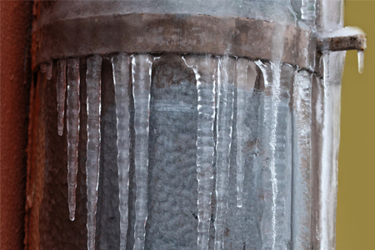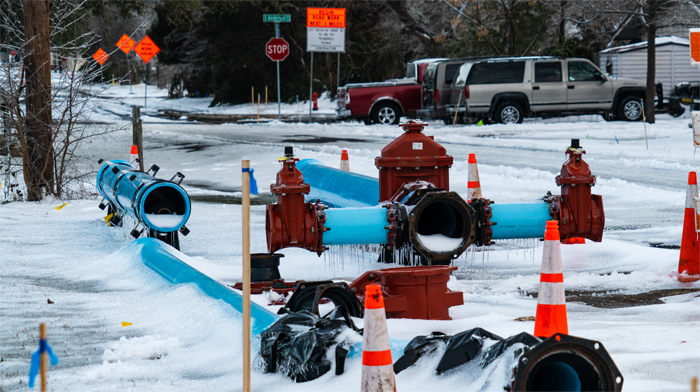Shoring Up Warm-Climate Water Systems To Weather Deep Freezes
By Stephanie Bache and Joe Aillet

The 2021 Texas freeze was a hard lesson learned for the state’s water utilities, but others can be more prepared as a result.
For decades, the aging of water and wastewater infrastructure has been the industry’s greatest concern, stoking stakeholders’ worries about the reliability and resilience of such assets against the ravages of a dramatic weather event.
One week last February in Texas brought it all into sharp focus. A historic, deadly deep freeze pummeled much of the Lone Star State, spawning widespread power outages that disrupted water and treatment systems, froze and burst pipes, and left millions without clean drinking water.
That cascading fallout shined a spotlight on the readiness — or lack thereof — of water suppliers and wastewater-treating sites in warm U.S. climates, begging the question at a time when concerns about climate change and the severe weather episodes they produce are rising: When it comes to weatherizing or hardening water infrastructure, what can, and should, decision-makers do to defend those assets against such calamities almost certain to recur?
The short answer is “plenty,” understanding that emergency preparedness always must be part of the tool kit used against the disruptive events increasing in frequency and costs. According to the National Oceanic and Atmospheric Administration, events estimated to result in at least $1 billion in damages have soared, from roughly three per year in the 1980s to about a dozen each year in the 2010s, creating a significant burden on infrastructure.
Attacking the issue takes thoughtful introspection about the potential threats and the cost-benefit of implementing the suite of hardening options. Are there enough redundancies and levels of preparedness in the right places? What assets are critical to the mission of a water utility, and what would happen if it lost power for not only hours or days but weeks? Does it need to add generators or even an independent power source? What rate increase will customers tolerate to protect against future outages?
Based on their customers’ expectations, it’s up to each water utility to determine its target level of resilience and to develop a plan to get there. Sorting it all out doesn’t have to be daunting, given the available practical options that set the foundation for heading off potential trouble.
SCADA
Ensuring the safe, efficient operation of water infrastructure begins with supervisory control and data acquisition (SCADA) systems. Several key factors that involve SCADA include field instrumentation and components, communication systems, and operator interfaces. The ability to monitor and control remote devices is critical to the system’s commercial operation and the understanding of how and where water and wastewater effectively get to their intended destinations.
Many utilities have either aging or insufficient SCADA systems that may prove to be unreliable during critical weather events, rendering operators blind as to how their system is performing. Having an updated SCADA system is critical to understanding a system’s reliability. Using historical SCADA data collected during a weather event in conjunction with hydraulic distribution models can accurately replicate how well a system performed and identify the critical infrastructure upgrades needed to maintain adequate system pressures during power outages.
Think of SCADA as four crucial “Rs” — reliability, resistance, and response and recovery.
Reliability speaks for itself, ideally rooted in a good organizational game plan and an acceptance that remote operations are entrusted to be a utility’s eyes on the ground. With SCADA, reliable data about the workings of assets such as instrumentation, control valves, and pumps are essential; and outages during extreme weather events can cause those instruments or devices to fail. In such situations, having emergency backup power sources may be the key.
Resistance can begin with a proactive, preventative maintenance plan that includes annual calibration of all instrumentation and a thorough examination of whether devices are properly connected and functioning. Such proactive planning can be vital during weather emergencies, giving technicians confidence that they have accurate information at their fingertips if troubleshooting is required. Practicing emergency scenarios is recommended, offering insight into how SCADA systems are handling and how operators address the issues that crop up.
Response and recovery are like coaches and players reviewing game films, critiquing what played well and, most importantly, what failed. Data and hydraulic models are analyzed in what should be a quest to build a hardened system, folding them into the utility’s reliability plan.
All of this should be a continuous and constantly updated cycle.

Frozen pipes from Winter Storm Uri, which ravaged Texas in February 2021.
Hydraulic Modeling And Digital Twins
Beyond exploiting the benefits of advanced data, utilities with aging or frail water systems can augment their winterization efforts by digitally replicating their physical assets to get historical, current, or predictive analyses in near real time.
Welcome to the world of digital twins, the utility sector’s equivalent of a flight simulator. As a potentially huge addition to utility intelligence, integrated digital twins can support effective decision-making and failure-prevention efforts. By combining information technology (IT) and operations technology (OT), utilities can simulate a range of weather and other scenarios to help guide operators’ decisions and optimize performance of existing assets.
Sensor deployments, metering, increasingly smart data modeling, digital twins, and analytics provide new levels of expansive insights that can complement institutional knowledge — before veteran workers retire — to create a permanent record of critical system functions that can be studied, refined, and improved.
The big picture: Detailed, data-driven asset planning not only helps utilities prepare their assets in advance of weather events but also helps utility personnel effectively handle these situations as they occur. If a water or treatment plant’s operators are complaining about whether pumps are working properly — or if there’s trouble maintaining tank levels — modeling can test those performances under expected conditions, help pinpoint the problems, and bring about thoughtful solutions before actual disaster strikes.
Other planning should address questions about power and the critical utility systems that need to remain functioning: What would happen during an outage lasting one day, three days, or a week? What needs to be done to maintain emergency water for customers? What facilities are absolutely critical to serve during an emergency? Should generators be added?
In short, models are invaluable in proactively helping evaluate existing and future emergencies, identifying everything from potentially overloaded pipes and bottlenecks to pressure surges and/or tank issues.
Hardening Your System
Once utilities take a step back and determine their vulnerabilities, the next goal would be to ascertain single points of failure and what improvements can be implemented to reduce the utility’s overall risk.
Steps should include scrutinizing the efficacy of the utility’s heat tracing and exposed small-diameter piping, which might be best buried or enclosed as a hedge against freezing weather. Critical instrumentation that is outdoors could be evaluated for alternative devices or migrated into cabinet enclosures with small heaters as safeguards against icy events.
And in cases of pipelines and pump systems that were especially susceptible to wintry events because they were stagnant, can drains be installed in such systems to prevent potential damage of freezing water? For extreme wet weather events, the utility can explore raising sensitive equipment or building physical barriers such as berms around the site.
Microgrids, Battery Storage As Onsite Power Options
For many water and wastewater utilities striving to winterize and protect against other extreme weather events, loss of power is the elephant in the room. Enhancing resiliency starts with identifying ways to mitigate exposure to outages and addressing two key questions: “What is needed, and how can redundant, standby power be incorporated into the system?”
A proven solution can be a microgrid — a source of green, cheap power when it’s needed the most.
Such technologies are any distributed energy resource that can be rapidly dispatched — everything from a battery to a natural-gas- powered generation setup — when conditions demand it. Microgrids can be supplemented by solar and fuel cells, along with other technologies, that are intermittent and therefore less reliable.
Generators also are an option, with diesel-powered backup energy sources often being converted to ones using natural gas that emits less carbon.
Given the cost of both building and operating a microgrid, ownership structures of such a resource must be sorted out. Does the utility want to pay for it and own it, or would it be advantageous to simply leave that outlay and operation to someone else who ultimately will provide the cheaper, greener backup power? There are many options available on the market for providing redundant power that can be tailor-fit to the owner’s needs; these can be procured through a competitive selection process.
Administrative Resilience
Far beyond questions about the resilience and readiness of their physical infrastructures against the backdrop of ascending concerns about climate change, water and wastewater utilities would be well-served by being introspective about something crucial but often overlooked.
Call it administrative readiness.
Falling far outside the scope of the reliability of visible physical assets, utilities can bolster their management and institutional preparedness.
Physical addresses of mission-critical customers — entities such as hospitals, food services, power suppliers, and military sites — should be updated and readily retrievable, giving utility operators and decision-makers a quick, ready reference point of where critical infrastructure resides within their service area when a catastrophic event develops.
Given that customers increasingly are young and digitally connected, social media policies and platforms should be updated, knowing that sites such as Facebook and Twitter serve as valuable and popular ways to engage the community in real time about storm events. Utilities would be wise to begin promoting their social media sites now in billing fliers and other correspondence, making customers aware that they are the go-to places for crucial details during catastrophic events.
Cross-training crews also gives utilities both flexibility in their capacity to address extreme events at any given moment and the peace of mind of knowing that they have sufficient numbers of employees to handle a breadth of necessary work.
Another area of administration resilience includes vendor contracts. Incorporating “first right of refusal” in matters of fuel, chemical, and equipment such as valves, fittings, and small-diameter piping should be considered.
Considering these steps — and taking action to implement them — will help prepare your utility for the next emergency event.
About The Authors

Stephanie Bache is a regional director with Black & Veatch.

Joe Aillet is a regional manager with Black & Veatch.
